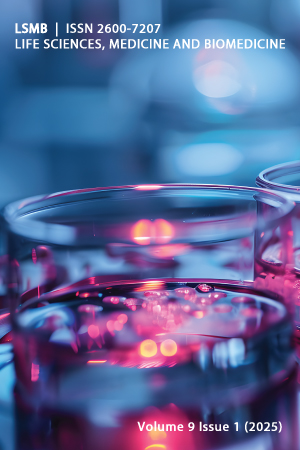Abstract
Lip cosmetics present a challenging identification and differentiation of lip cosmetics in forensics, given their similar chemical compositions, particularly within the same colour category. The authors utilised attenuated total reflection spectroscopy and chemometrics to analyse 30 brown lip cosmetic samples across five categories: lip crayons, lip glosses, liquid lipsticks, lip pencils, and solid lipsticks. The major findings observed in the analysis of lip cosmetics included weak intensity spectra for key functional groups such as hydroxy, aliphatic, carbonyl-containing species, and ether. In addition, the hierarchical cluster analysis grouped most samples into two main clusters: lip crayons and most solid lipsticks in one, and most lip glosses, liquid lipsticks, and lip pencils. Principal component analysis revealed clear clusters of lip glosses, liquid lipsticks, and lip pencils, with scattered lip crayons and solid lipsticks. Furthermore, trace analyses yielded limited results, with only one trace (TR3T) showing similarity to the lip gloss (LG2) spectrum. This study sheds light on the complexities surrounding the differentiation of lip cosmetics. Further studies should study several types of lip cosmetics with varying shades and analyse their traces on different substrates to produce accurate, reliable, and generalised outcomes. These findings emphasise the need for more comprehensive investigations to enhance forensic analytical approaches.
References
Chophi, R., Sharma, S., & Singh, R. (2020). Forensic analysis of red lipsticks using ATR-FTIR spectroscopy and chemometrics. Forensic Chemistry, 17, 100209.
https://doi.org/10.1016/J.FORC.2019.100209
Ezegbogu, M. O., & Osadolor, H. B. (2019). Comparative Forensic Analysis of Lipsticks Using Thin Layer Chromatography and Gas Chromatography. International Journal of Chemical and Molecular Engineering, 13(5).
Gładysz, M., Król, M., Chudecka, A., & Kościelniak, P. (2020). Application of spectroscopic and separation techniques to the examination of the chemical composition stability of lipsticks exposed to various factors and storage conditions. Forensic Science International, 309, 110230.
https://doi.org/10.1016/J.FORSCIINT.2020.110230
Gładysz, M., Król, M., & Kościelniak, P. (2017). Differentiation of red lipsticks using the attenuated total reflection technique supported by two chemometric methods. Forensic Science International, 280, 130–138.
https://doi.org/10.1016/J.FORSCIINT.2017.09.019
Gładysz, M., Król, M., & Kościelniak, P. (2021). Current analytical methodologies used for examination of lipsticks and its traces for forensic purposes. Microchemical Journal, 164, 106002.
https://doi.org/10.1016/J.MICROC.2021.106002
Ka Khei, L., Verma, R., Tan, E. L. Y., Low, K. H., Ismail, D., & Mohamad Asri, M. N. (2023). Rapid and nondestructive analysis of lipstick on different substrates using ATR-FTIR spectroscopy and chemometrics. Journal of Forensic Sciences.
https://doi.org/10.1111/1556-4029.15223
Kaur, K., Yadav, P. K., Bumbrah, G. S., & Sharma, R. M. (2020). Forensic classification of lipsticks using attenuated total reflectance – Fourier transform infrared (ATR-FTIR) spectroscopy. Vibrational Spectroscopy, 110, 103146.
https://doi.org/10.1016/J.VIBSPEC.2020.103146
Larkin, P. J. (2011). Infrared and Raman Spectroscopy: Principles and Spectral Interpretation. In Infrared and Raman Spectroscopy; Principles and Spectral Interpretation. Elsevier Inc.
https://doi.org/10.1016/C2010-0-68479-3Mohamed Ghazali, F., & Ismail, D. (2018). Forensic discrimination of lipstick smears using attenuated total reflectance-Fourier transform infrared (ATR-FTIR) spectroscopy with chemometrics techniques. The International Journal of Medicine and Sciences, 3(1), 48–52.
https://tijms.unishams.edu.my/images/pdf_file/vol3/farhana_2018.pdf
Resolution and Aperture. (n.d.). Shimadzu. Retrieved 22 March 2024, from https://www.shimadzu.com/an/service-support/technical-support/ftir/tips_and_tricks/aperture.html
Sharma, S., Singh Sahota, S., & Kumar Garg, R. (2016). Investigation on the aged lip-gloss stains by TLC and FT-IR. International Journal of Medical Toxicology & Legal Medicine, 19(1–2), 36–41.
https://www.indianjournals.com/ijor.aspx?target=ijor:ijmtlm&volume=19&issue=1and2&article=007
Sharma, V., Bharti, A., & Kumar, R. (2019). On the spectroscopic investigation of lipstick stains: Forensic trace evidence. Spectrochimica Acta Part A: Molecular and Biomolecular Spectroscopy, 215, 48–57.
https://doi.org/10.1016/J.SAA.2019.02.093
Thompson, J. M. (2018). Infrared Spectroscopy (1st ed.). Jenny Stanford Publishing.
https://doi.org/10.1201/9781351206037
Wong, J. X. W., Sauzier, G., & Lewis, S. W. (2019). Forensic discrimination of lipsticks using visible and attenuated total reflectance infrared spectroscopy. Forensic Science International, 298, 88–96.
https://doi.org/10.1016/J.FORSCIINT.2019.02.044
Yadav, A., Nimi, C., Sharma, S., Kaur, J., & Singh, R. (2023). A comprehensive ATR-FTIR spectroscopic analysis for the identification and differentiation of lip balms. Journal of Forensic Sciences, 68(6), 1972–1981.

This work is licensed under a Creative Commons Attribution 4.0 International License.
Copyright (c) 2025 Hajera Thakur, Nurul Ain Abu Bakar, Muhammad Naeim Mohamad Asri

